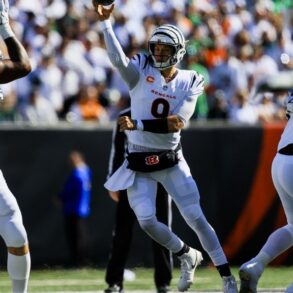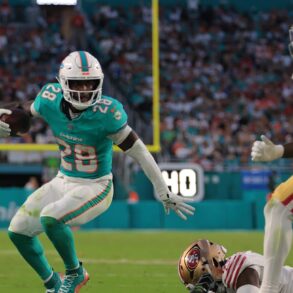Free Agency Definitions
What are the categories of free agency?
Unrestricted Free Agent (UFA): Any player with an expired contract who has accrued four or more seasons (an accrued season is a season in which a player is on a club’s active/inactive, reserve/injured or reserve/physically unable to perform lists); these players are free to negotiate and sign with any team as of March 12.
Bengals TE Mike Gesicki is an example of an unrestricted free agent.
Restricted Free Agent (RFA): Any player with an expired contract who has accrued three seasons. RFAs are free to negotiate and sign with any team as of March 12, but their original team can offer them one of various qualifying offers (“tenders”) that come with the right of first refusal and/or draft-pick compensation. (More below).
Bengals LS Cal Adomitis is an example of a restricted free agent.
Exclusive Rights Free Agent (ERFA): Any player with an expired contract who has accrued fewer than three seasons. If his original team offers him a one-year contract at the league minimum (based on his credited seasons), the player cannot negotiate with other teams.
Bengals P Ryan Rehkow is an example of an exclusive rights free agent.
What is the difference between a restricted free agent and an unrestricted free agent?
In the 2025 league year, players with three accrued seasons who have received a qualifying offer become restricted free agents when their contracts expire at the conclusion of the 2024 league year on March 12. Unrestricted free agents have completed four or more accrued seasons. Upon expiration of his 2024 contract, an unrestricted free agent is free to sign with any club with no draft-choice compensation owed to his old club.
What constitutes an “accrued season”?
Six or more regular season games on a club’s active/inactive, reserve/injured or reserve/physically unable to perform lists.
How do the free agency rules apply to restricted free agents?
If a player with three accrued seasons has received a “qualifying offer” (a salary tender predetermined by the Collective Bargaining Agreement between the league and its players) from his old club, he can negotiate with any club through April 18. If the restricted free agent signs an offer sheet with a new club, his old club can match the offer and retain him because the qualifying offer entitles it to a “right of first refusal” on any offer sheet the player signs. The deadline for clubs to exercise Right of First Refusal is April 23.
If the old club does not match the offer, it may receive draft-choice compensation depending on the amount of its qualifying offer. If an offer sheet is not executed on or before April 18, the player’s negotiating rights revert exclusively to his old club. In addition, prior to the start of free agency a player who would otherwise be a restricted free agent may be designated by his old club as its franchise player or transition player.
What determines an unrestricted free agent?
A player with four or more accrued seasons whose contract has expired. He is free to sign with any club, with no draft-choice compensation owed to his old club, through July 21 (or the first scheduled day of the first NFL training camp, whichever is later). At that point, his negotiating rights revert exclusively to his old club if by April 26 the old club tendered the player a one-year contract for 110 percent of his prior year’s salary.
His old club then has until the Tuesday following Week 10 of the regular season to sign him. If he does not sign by that date, he must sit out the season. If no tender is offered by April 26, the player can be signed by any club at any time throughout the season.
What determines a franchise player?
The salary offer by a player’s club determines what type of franchise player he is: exclusive or non-exclusive.
An “exclusive” franchise player – not free to sign with another club – is offered the greater of (i) the average of the top five salaries at the player’s position for the current year as of the end of the restricted free agent signing period on April 18; or (ii) the amount of the required tender for a non-exclusive franchise player.
If a club extends a required tender to a “non-exclusive” franchise player, the player can negotiate a player contract with any club, and draft-choice compensation of two first-round draft selections shall be made in the event he signs with a new club.
How many franchise players and transition players can a team designate each season?
A club can designate one franchise player or one transition player among its potential restricted or unrestricted free agents.
Can a club decide to withdraw its franchise or transition designation on a player?
Yes. A club can withdraw its franchise or transition designation, and the player then automatically becomes an unrestricted free agent, either immediately if the tender is withdrawn after the start of the 2025 League Year, or when his 2025 contract expires if the tender is withdrawn before the start of the 2025 League Year.
This post was originally published on this site be sure to check out more of their content.





